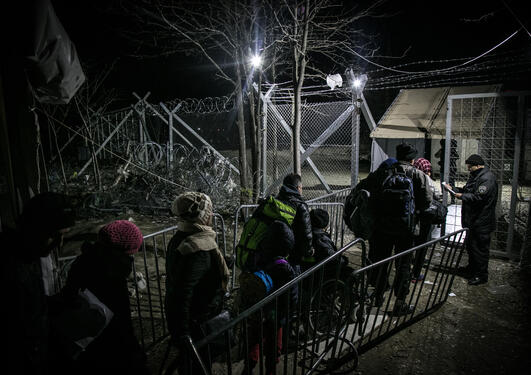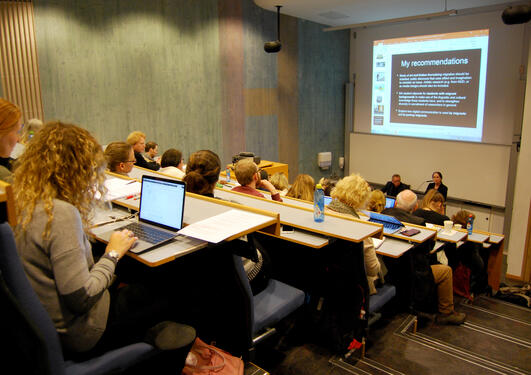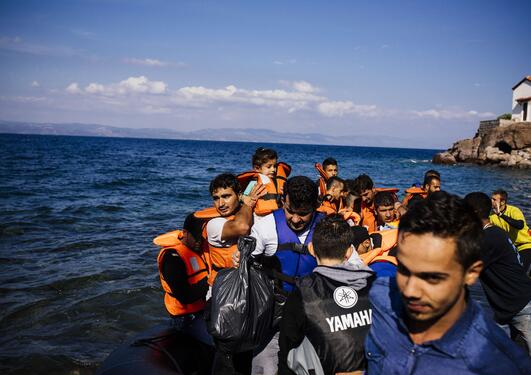
Sharing research results and analysis on migration policy
Different aspects and paradigms of European asylum policy were presented when the University of Bergen held a one-day migration conference in Brussels.
Main content
On 23 May, the University of Bergen (UiB) and Bergen International Migration and Ethnic Relations Research Unit (IMER) invited participants from all over Europe to the conference Whither European asylum policy? A pendulum between universalisation and re-nationalisation in Brussels.
At the conference, the participants shared their research findings and analysis on the common asylum procedure suggested within the framework of the EU's Common European Asylum System (CEAS).
Migration research a UiB priority
The conference was opened by the Dean of UiB's Faculty of Social Sciences, Professor Jan Erik Askildsen, who underlined the importance of basic research on migration policy.
“Migration is a visible and active research area at the University of Bergen,” said Dean Askildsen in his opening remark, describing the event as an “innovative conference on migration policy.”
“With the introduction of CEAS, the EU has become an important global trendsetter in asylum policy-making. Against the urgent backdrop of the increasing migrations flows globally, it is critical for UiB to disseminate our unique research in this field to the EU and other stakeholders.”
Sponsor of the event, Ms Jean Lambert, MEP from the British Green Party, was delighted to see the level of the research presented at the conference. She has been one of the most active and vocal voices in the European Parliament in the debate on CEAS.
“Asylum seekers must be seen as agents and not as passive recipients,” said MEP Lambert when addressing the topic of CEAS after Dean Askildsen's opening remark.
In her speech she went on to underline the importance of basic research to underpin current and future asylum policy, both in the EU and the rest of Europe.
Looking at legal and institutional frames for migration
Professor Hakan G. Sicakkan of UiB's Department of Comparative Politics opened the scientific debate on CEAS at the conference. Previously he was principal investigator in the FP7-supported pan-European research project EUROSPHERE.
“How do different legal and institutional frames work in the EU's Common European Asylum System,” asked Sicakkan at the start of his speech before going on to offer an unique research approach to the EU's migration policy at the conference.
“There are two paradigms of asylum policy at work: one universalistic human rights approach and the particularistic citizen/alien approach. This also sums up the main difference between the international law and the national asylum policy practices,” said Sicakkan, who was the academic convenor for the migration conference.
He pointed out that the EU's new reform proposal on asylum procedures risks allowing member states to adopt a particularistic approach, which may break systematically with the Geneva Convention in many cases. He then presented his own unique research method, which has resulted in the discovery of concrete institutional and procedural processes in processing asylum cases. These processes enable nation states to violate international law in a subtle manner.
FACTS
IMER
- Bergen International Migration and Ethnic Relations Research Unit (IMER) is a multidisciplinary migration research network.
- The research unit was established in 1996.
- Located at Uni Research Rokkan Centre and the University of Bergen (UiB).
- Aims to contribute to research-based knowledge about international migration, including the consequences of immigration and emigration for societies.
- IMER is a priority research area at UiB's Faculty of Social Sciences.
- Migration research is a UiB strategic priority as part of one of the university's three focus areas: Global Challenges.
- See more on the IMER webpage.
The concept of ‘waitinghood’
Professor and anthropologist Christine M. Jacobsen from UiB's Centre for Women's and Gender Research offered the probably most original concept of the conference when she introduced “waitinghood”, which describes how asylum seekers may end up in limbo as they apply for asylum status and are left waiting in a state of uncertainty.
“We developed the concept of ‘waitinghood’ whilst investigating how ‘waiting’ is legally and socially produced as well as encountered, incorporated and resisted by migrants,” explained Jacobsen about this original concept that has raised eyebrows both among fellow researchers and policy-makers.
The anthropologist heads the interdisciplinary and comparative research project Waiting for an Uncertain Future, the temporalities of irregular migration (WAIT), funded by the Research Council of Norway.
“In the WAIT project we look especially at migrants whose entry and stay is deemed ‘irregular’ by the state,” said Jacobsen, “to develop good migration governance, we need to investigate how situation of prolonged waiting, uncertainty and temporariness are produced and sustained, and how the temporal aspects of migration governance affect the health and wellbeing of migrants.”
Fellow anthropologist Synnøve Bendixsen elaborated on irregular migration when she spoke on assisted return policy from a migrant perspective. Her research on internal border construction in Norway has put the issue of precariousness, discourse of humanitarianism and political agency of noncitizens at the heart of migration policy research.
“Assisted return is one of the main Norwegian priorities in the work on reducing irregular migration,” said Bendixsen, who is co-editor of Approaches to Social Inequality and Difference, a major series of anthropological books at the publisher Palgrave-MacMillan.
Based on her research, she concluded by pointing to four measures to improve future asylum policy.
“Distinguish sharper between assisted return and deportation policies. Provide assistance to understand the return letter. Denaturalise the policy of return. And finally, develop and implement a more used-friendly and oriented policy, which includes ethical guidelines and more information and understanding of what return means for the individual,” she said.
Using data in migration policy research
Sociologist Susanne Bygnes is part of the social sciences digital infrastructure project DIGSSCORE, which incorporates the Norwegian Citizen Panel, and was recently awarded a major grant from the Research Council of Norway for her Imagining and Experiencing the ‘Refugee Crisis’ (IMEX) project.
“My starting point for this project was the increase in asylum arrivals to Norway in 2015 and to investigate how local populations and newcomers imagined and experienced this ‘crisis’,” explained Bygnes whilst presenting an extensive selection of data-based research on this particular flow of migration to Norway.
“The key findings were a temporary opinion backlash where the Norwegian population's attitudes to immigration became more negative,” said Bygnes, “however, those with actual experience of having an asylum centre in the neighbourhood were more accepting than those without such an experience.”
The conference was organised by the University of Bergen together with MEP Jean Lambert, who was one of the main speakers at the conference. The university has global challenges as one of its three strategic priority areas and the one-day conference was supported and facilitated by the governing board of the priority area, from which the co-chair Professor Marit Bakke attended the conference.
FACTS
CEAS
- The Common European Asylum System (CEAS) is the basis for the EU's asylum policy.
- CEAS aims to secure the rights of asylum seekers by harmonising the different EU member states' asylum procedures.
- CEAS suggests some common measures for effectiveness and efficiency that are less resource-demanding and more cost-effective than many of the individual states procedures.
- Questions remain concerning evidence that these measures also guarantee a proper protection of the rights of asylum seekers.
- The research and knowledge presented at the 23 May one-day conference in Brussels put the spotlight on these measures and their effectiveness.
- More information on CEAS.



